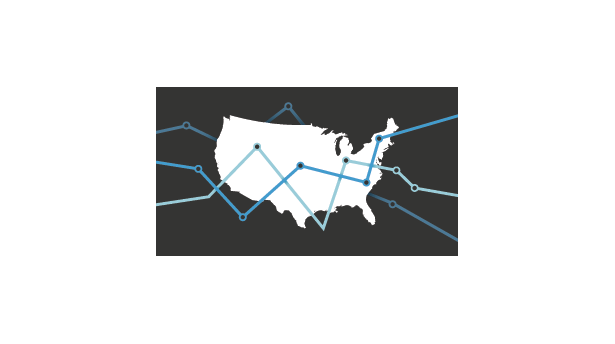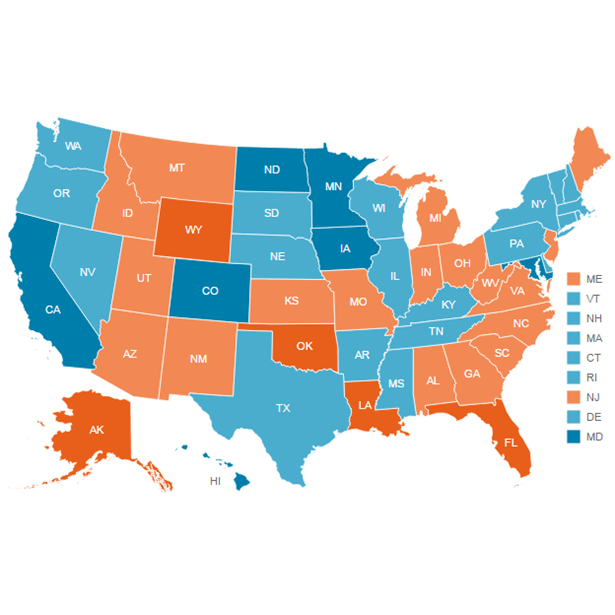Employment Climbs Closer to Pre-Recession Rates
The U.S. employment rate for adults of prime working age rose during the 12 months that ended in June 2017, yet remained clearly lower than in 2007, just before the Great Recession. Reflecting the national trend, the percentage of 25- to 54-year-olds with a job was clearly lower in 15 states.
The U.S. employment-to-population ratio for 25- to 54-year-olds, which measures the share of people in their prime working years who have jobs, averaged 78.2 percent during the fiscal year ending in June 2017, up from 77.6 percent a year earlier. Despite rising for years, the prime-age employment rate was still below 2007’s level of 79.9 percent. In the wake of the 2007-09 recession, the employment rate hit lows of about 75 percent.
For every 100 prime-working-age adults nationwide, 1.7 fewer had jobs in fiscal 2017 than before the recession. About 2.1 million fewer prime-age adults had jobs compared with 9½ years earlier. Lower employment can mean lower tax revenue for state governments.
Despite a continuing employment-rate gap among prime-age workers, which shows that there’s still room for improvement in the labor market, recent years have seen signs of progress. In 2012, when Pew’s analysis of the data began, 37 states had employment rates that lagged 2007 levels by a statistically significant amount. That count dropped to 35 in fiscal 2013, 29 in fiscal 2014, 23 in fiscal 2015, and 18 in fiscal 2016. By fiscal 2017, the number had fallen to 15. Most other states in the most recent fiscal year had rates that were below pre-recession levels, but not by statistically significant amounts. No state’s rate had surpassed 2007 levels by a statistically significant amount.
Even as the employment-rate gap has persisted, a better-known measure—unemployment—has improved, falling close to pre-recession rates. Among prime-age workers, the unemployment rate in the year through June 2017 was 4.0 percent—down from a peak of 8.7 percent in 2010—compared with 3.7 percent in 2007. While employment and unemployment rates are related, they measure somewhat different groups. The chief reason that the prime-age employment rate remained lower in fiscal 2017 than during the year before the recession was an increase in the share of people neither working nor looking for work—a group that is not counted in the unemployment rate.
State highlights
A state-by-state comparison of the difference in the employment-to-population ratio for 25- to 54-year-olds between calendar 2007 and fiscal 2017 shows:
- Among the 15 states with statistically significant differences in their employment rates, the largest difference was in New Mexico. For every 100 prime-working-age New Mexicans, seven fewer were employed.
- Employment rates were lower in an additional 29 states but not by statistically significant amounts, so it is unclear whether their rates had recovered.
- Rates were higher in Michigan (by 1 percentage point), Wisconsin (0.9 point), Massachusetts (0.7 point), Oregon (0.1 point), Indiana (0.03 point), and Vermont (0.02 point). However, the differences were not statistically significant.
- One state—Rhode Island—fell off the list of those with statistically significant differences in their employment rates. This means that Rhode Island’s rate was probably closer to its pre-recession level than it was last year.
How employment affects state ledgers
Economic conditions, including employment, are major drivers of state finances. Changes in employment rates among adults in their prime working years can affect both sides of a state’s budget ledger.
- Revenue: Paychecks help generate individual income tax dollars and fuel consumer spending, which produces tax revenue from sales and business income.
- Expenditures: People without jobs frequently need more services such as Medicaid and other safety-net programs, which can increase states’ costs.
What is the employment-to-population ratio.
Although unemployment figures receive substantial media attention, many economists also track the employment-to-population ratio because it provides a broader view of labor market conditions. The unemployment rate, for example, excludes people who are not looking for jobs, but the employment rate captures this group in its measurement of population.
Focusing on 25- to 54-year-olds reduces the distortion of employment trends resulting from demographic effects such as older and younger workers’ choices regarding retirement or full-time education.
Another gauge of employment trends is the labor force participation rate. While the employment-to-population ratio tracks the percentage of the population that has jobs, the labor force participation rate measures the percentage that is working or actively looking for work.
A statistically significant decrease or increase indicates a high level of confidence that there was a true change in the employment rate. Changes that are not statistically significant offer less certainty and could be the result of variations in sampling or other methods used to produce employment estimates. Without additional testing for statistical significance, caution should be exercised when comparing changes in employment rates among states.
Download the data to see individual state trends. Visit Pew’s interactive resource Fiscal 50: State Trends and Analysis to sort and analyze data for other indicators of state fiscal health.









